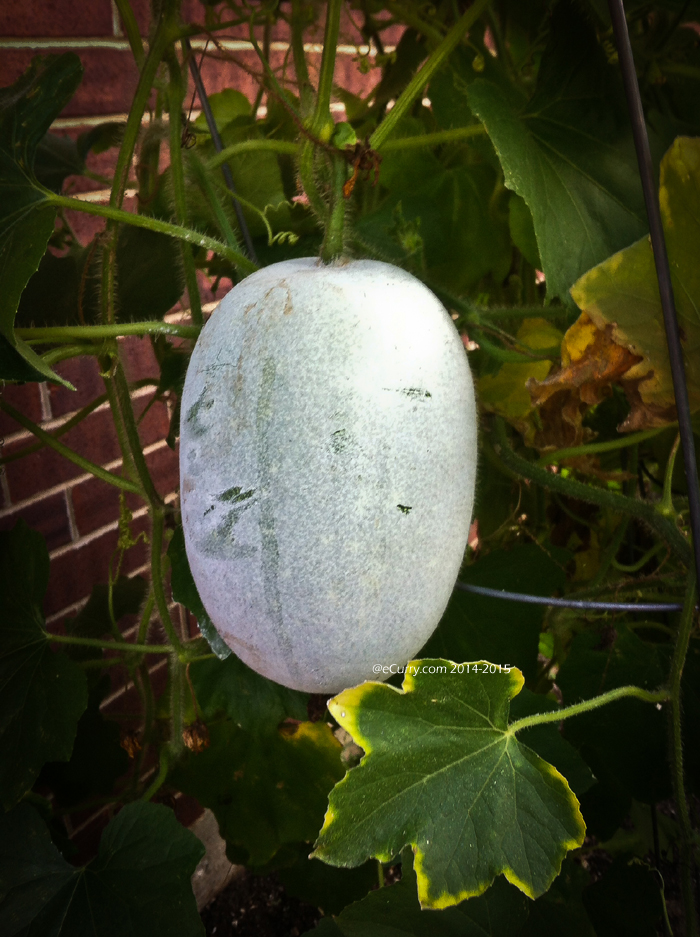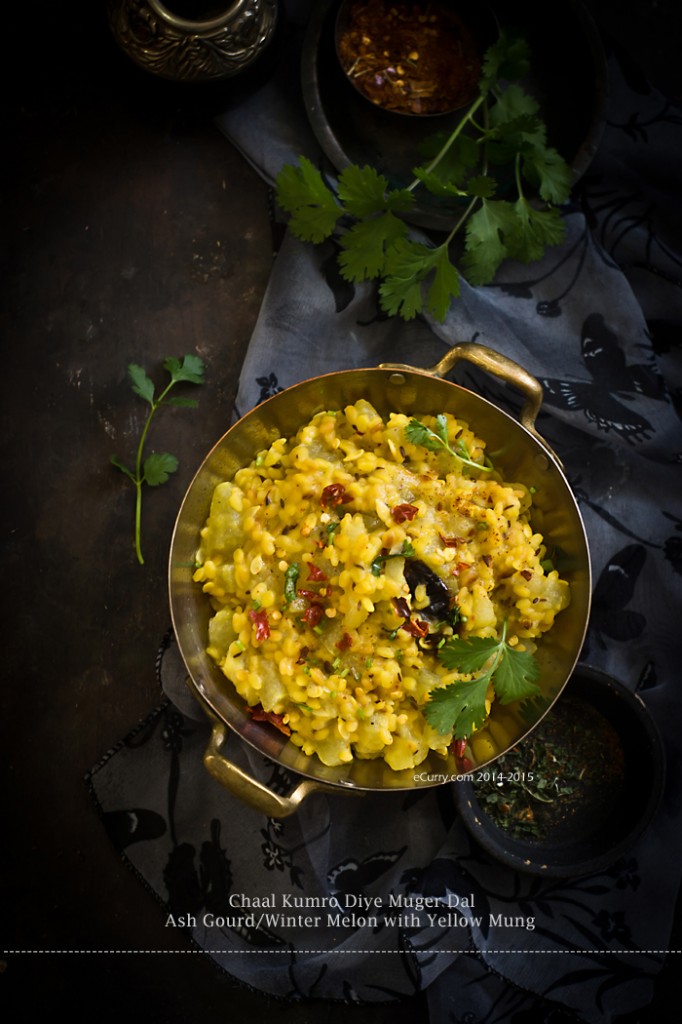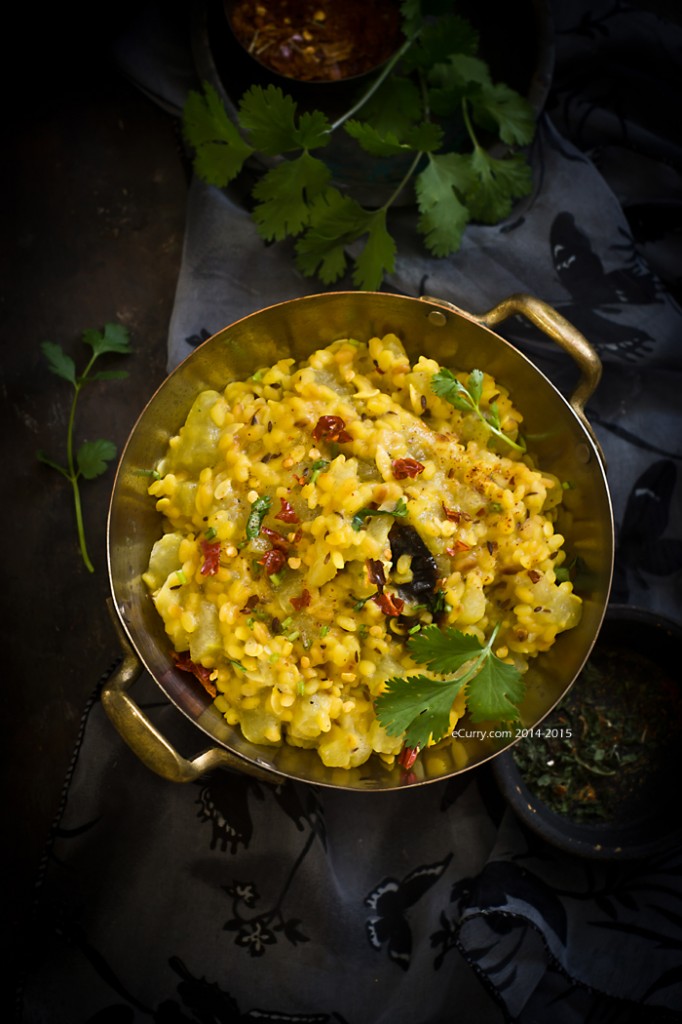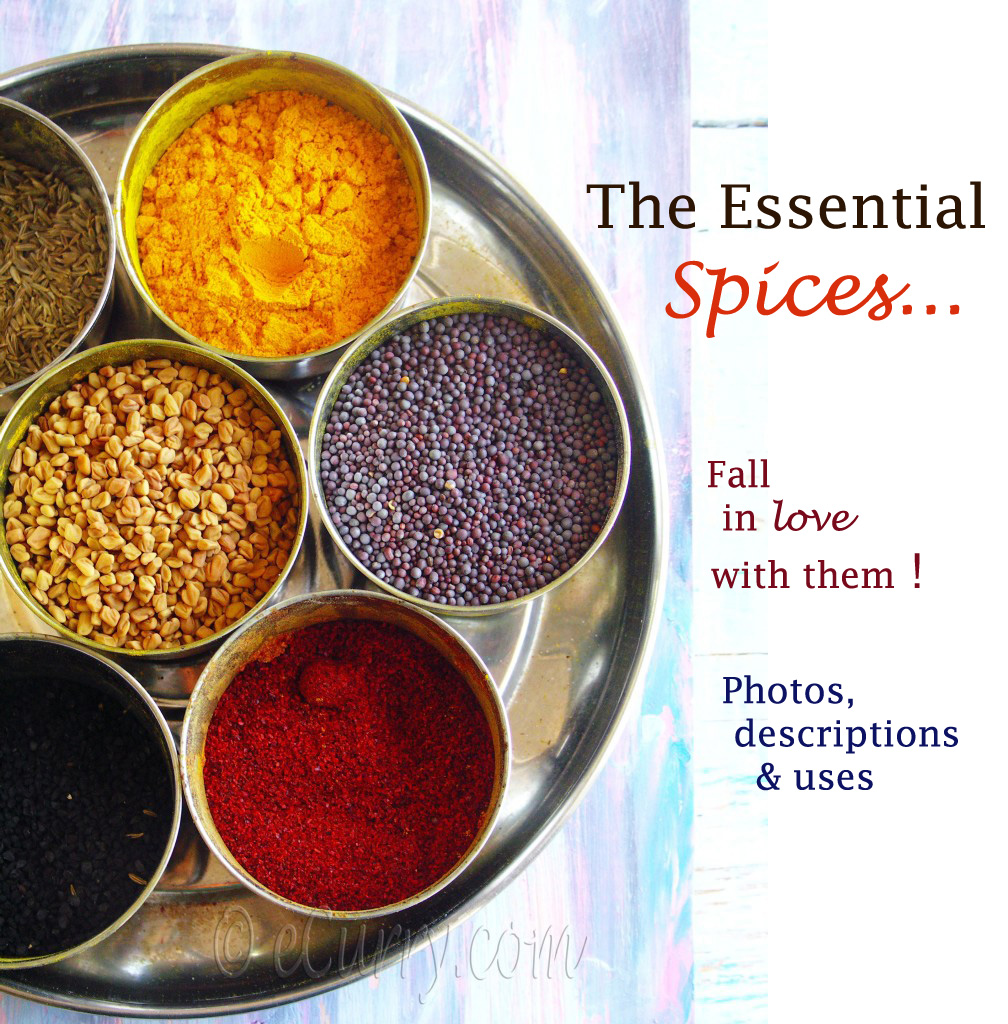
A few times a year, I get the gift of indulging into a full blown elaborate Bengali meal. The times when my dad visits, and then there are those times when my cousin comes over. There is nothing more beautiful than sharing a familiar spread of flavorful comfort with the two very special people of my life.

This dish is a part of a traditional Bengali meal: a simple and nourishing recipe, served as a side along with steaming hot white rice. The yellow mung is toasted until golden. Aromas fill every corner of the house.

For the past few weeks I have been taking care of the vegetable garden of a friend who is visiting his home in India. His yard is bliss. A farmer’s market in true sense with every corner reminding of my home. Vegetables that I grew up with and crave for now. Vegetables that filled the back of our house and the way they crept and crawled on our terrace: everything we tended and enjoyed during my childhood days.

I get to bring back home whatever is growing and are ready to pick on that day. For several weeks now I have not bought a single vegetable from the store. I had got all the vegetables from his garden when I made the Avial.

So when my cousin visited me again, we took a stroll in his garden and down the memory lane. We knocked down fruits with the pole and sat and ate them. We filled our bags with fresh vegetables, squealing every time we found one. And when I saw this Ash Gourd or Chaal Kumro hanging from the vines, we were beyond thrilled.
The Bengali name Chaal Kumro comes from Chaal (which means the roof or even the roof like support on which the vine climbs) and Kumro is a term used for gourds in general.
I am assuming the Winter Melon is the same as this or belongs to the same family with similar taste and flavor.

I do not know how many years it has been since I had home-grown Chaal Kumro (Ash Gourd). However once I got back home and cooked it, I had doubts since the seeds were way smaller and the texture seemed a bit different than what I was used to. It tasted really close but not quite. So I posted on the Facebook page, wondering if this could be something of the same variety but a different vegetable. Most readers confirmed that it was indeed Ash Gourd. It could have been just not mature enough to toughen the seeds and the taste.

This dish is traditionally cooked with bottle gourd (lau/lauki/opo squash). But ash gourd or chaal kumro or winter melon is very close to taste and texture to bottle gourd and is good enough to substitute the squash. It does take a tiny bit longer to cook.
So we cooked. My sister and I. Then we ate a big traditional meal which included the Chaal Kumro diye Muger Dal and Macher Jhal among the other things. We talked and giggled, rummaging memories and days of our close knit childhood days. Needless to say, one of the best meals eveer.

Chaal Kumro Diye Muger Dal: Ash Gourd/Winter Melon with Yellow Mung
Ingredients: (serves 4-6 a side)
- 1 medium ash gourd/wax melon/bottle gourd or opo squash/lauki/lau (about 4-5 cups chopped)
- 3/4 -1 cup yellow mung
- 1 tablespoon pure mustard oil or ghee + 1 teaspoon ghee (use mustard oil or any other oil for a dairy free recipe. mustard oil adds lovely flavor but any other oil can be used too)
- 2 dry red chili pepper
- 1 green chili pepper, slit
- a generous pinch of hing/asafoetida
- 1 teaspoon cumin seeds
- 1 tej patta/Indian bay leaf
- 1 teaspoon turmeric
- salt to taste
- fresh cilantro for garnish
- fried Bori/Vadi or sun dried dumplings for garnish – optional
*Note: I have used Ash gourd/Winter melon here. The recipe is based on the traditional Bengali recipe “Lau diye Bhaja Muger Dal” (Bottle Gourd/Opo Squash with toasted yellow mung). The dry version of the dish. However any gourd/melon/squash can be used like I have done today. Ash gourd is very similar to Opo Squash except it takes a little longer to cook.
Method:
Peel the gourd/melon. If the seeds are hard and ripened you will need to remove them. Slice the gourd/melon in half and then in fourths and slice off the seeded part. Chop the gourd/melon in little cubes. Wash and set aside.
In a skillet, place the yellow mung on the hot skillet and toast/roast them while you stir frequently to prevent them from getting dark brown. Once they turn a deep golden shade (some of them will have a brown tinge) and becomes fragrant, remove the skillet from heat. Transfer them to a bowl and let cool.
Washing the lentils is optional.
Heat ghee or oil in a pan or wok/kadai with tight fitting lid. Add the cumin seeds and when they splutter add the asafoetida, green chili pepper, dry red chili pepper and the tejpatta/Indian bay leaf. When the red dry pepper starts to turn brown, add the chopped gourd/melon, salt and turmeric and toss well. Now add the toasted lentils, toss well again so the lentils are evenly distributed. Cover tightly and cook. The vegetables will release water and the vegetable and the lentils will cook in steam and in their own liquid. Cook for about fifteen minutes in medium to low heat.
Uncover, toss and test to see the doneness of the vegetable and the lentils. The gourd/melon should start to look transluscent, and will soften. The lentils will get tender. It is done when the gourd/melon starts to mush and the lentils will be soft, but not broken down. They should mush when squeezed between fingers but the lentils will still hold their shape. If still not done, cover it back and cook until done. If you see there is no more liquid, add some more.
When done, all the liquid should be absorbed. It should be dry but nicely moist. Adjust salt. Keep covered until ready to serve.
Before serving add a teaspoon of ghee and gently toss. This is an optional step.
Garnish with fresh cilantro/coriander and serve as a side. Traditionally it is served with hot white rice.
Preparation Time: 15 minutes
Cooking Time: 20-30 minutes
Difficulty Level: Easy
Serves: 4-6

Related Posts:
- A visit to the Pumpkin Patch: The Spooks & The Spicy
- Butternut Squash with Black Beans and Walnuts
- Butternut Squash with Harissa and Coconut Milk
- Cabbage with Peas and Potatoes – Bandhakopir Torkaari
- Curried Butternut Squash with Brown Chickpeas
- Khatti Meethi Lauki – Sweet and Sour Bottle Gourd
- Labra: A Festive Combination of Vegetables and Spices
- Lau-er Khosha Bata: Chutney with Bottle Gourd Peel
- Lauki Chana Dal – Soupy Lentils with Bottle Gourd
- Shorshe Sheem: Hyacinth Beans cooked with Mustard Paste
- Vegetables & Lentils with Ground Spices












Looks gorgeous. That is what I love in Indian cuisine – this dish is simple yet delicious, fragrant and colorful.
Such an interesting post! I never knew much about this recipe, Eager to make it. Thanks for sharing this.
You are ones of the best cooks that I have come across ! you make the simple so special ! love you for everything !
This dish looks delicious and your meal sounds amazing! I love winter/fall squash and the spices in this recipe sound great. Thanks for sharing these beautiful photos too 🙂
I am a Bengali, this dish reminds my mother’s cooking
[…] This recipe is based on ‘Lau diye bhaja muger dal‘ – Is roasting dry daal the key to this? via […]